Tibetan People
- by Beatrice
- Last Updated: 2023-09-18
Curious to know more about the inhabitant and their lifestyle in Tibet? Tibetans are the most popular ethnic minority group in China, with a population of 7,500,000. As the aborigines of Qinghai -Tibet Plateau, Tibetan people mainly live in Tibet Autonomous Region, and some groupings in Qinghai, Gansu, Sichuan and Yunnan Provinces.
Tibetans are one of the oldest ethnic groups in China and South Asia. They have a long history of more than 1300 years, mysterious Tibetan Buddhism, a unique language, nomadic lifestyles, splendid culture including very high attainments in literature, music, dance, painting, sculpture, architectural art, etc. Here's just a brief introduction to the people of Tibet.
History
In the past, the ancestors of the Tibetans lived in Yaluzangbu River. Around the sixth century, the chief of the Yarlung tribe defeated many tribes to become a king. The name of the king was Zanpu. In the 7th century, Songtsen Gampo, the grandson of Zanpu, unified the whole Tibet and moved to Lhasa city. This is the so-called Tubo Kingdom in many Chinese histories today. In 1614, Songtsen Gampo got married to Wencheng, who was a princess of the Tang Dynasty. And he was allowed to be the King of western China by the emperor of the Tang Dynasty. At around 710, Xidezuzan, who is the king of Tibet then, also married Princess Jincheng from Tang Dynasty. Since then, Tibet and China have established good cooperative relations in culture, politics, and economy. In 1934, the Chinese government set up an affair office in Tibet, which led to the establishment of the Tibet Autonomous Region.
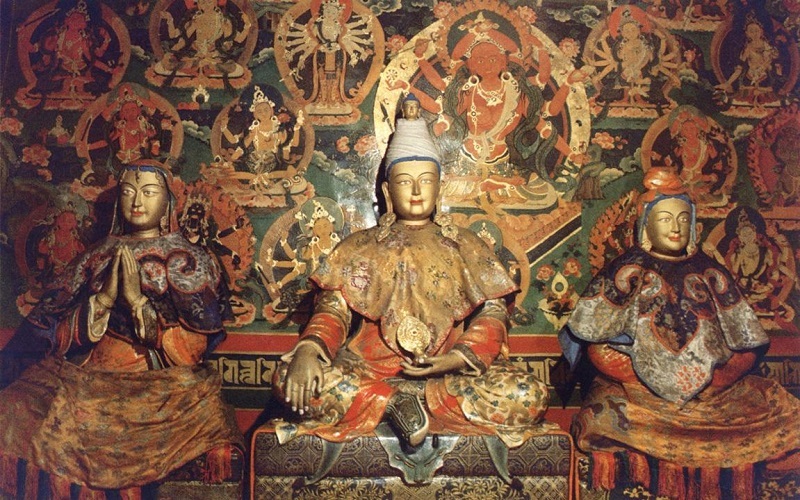
People’s lifestyle
The lifestyle of the Tibetans did not change until the 7th century. Most of them wear robes in their daily lives and most of the herdsmen in Tibet spend all their lives in this place by grazing sheep and yaks. Their women usually wear precious jewelry and flowers in their hair. And some of them cover their hair with clothes. Tibetan people will wear gorgeous clothes and their most beautiful headwear to participate in various annual Tibetan festivals such as Saga Dawa Festival, Ganden Thangka Festival, and Shoton Festival, etc.
Clothing in Tibet
Just like their charming personality, people in Tibet wear unique and traditional dresses. Being a high-altitude area, the local clothes in Tibet are warm, thick, have a full waist, long sleeves, and skirts. Their clothing is made of silk, wool, cotton, and sheepskin. To maintain the body temperature in hot weather, they take off one or two sleeves and tie them about the waist. For night sleep, they take off two sleeves and use the same clothing as a big sleeping bag. >> See more about Tibetan Clothing
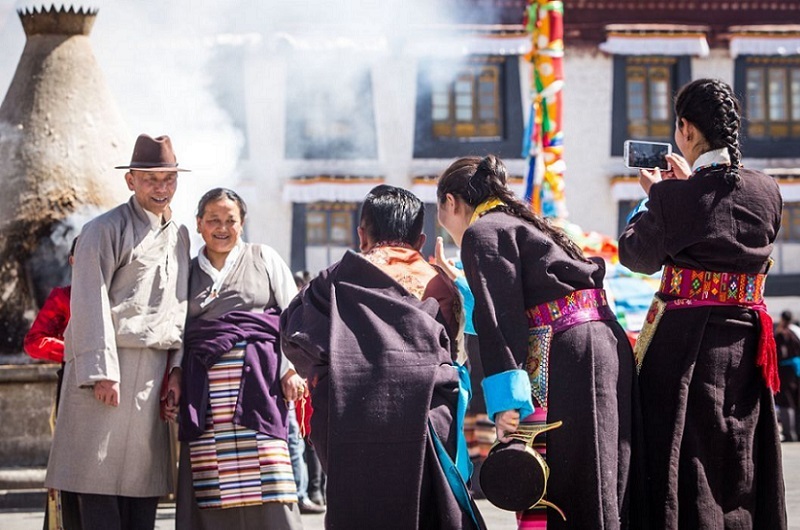
Tibet Inhabitants
Tibet is a city of various residents, including a significant population- Tibetans, and other inhabitants such as Menpa, Luopa, Han Chinese, Sherpa, Hui, and some Deng inhabitants. The major population, Tibetans, are 92% of the local people, and they are very friendly, cheerful, and bold people.
Food in Tibet
Tibetans are food-loving people, and their diet is unique and delicious. Tibetans love non-veg food; the leading food in the region is beef, mutton, and other dairy products. The vegetables are seldom seen in Tibet, specifically, in grassland areas.
Residents of Tibet also like raw meat. If you visit the local herdsmen there, you will see the dried lamb and beef at their places. Perhaps, they have delicious dishes to offer you.
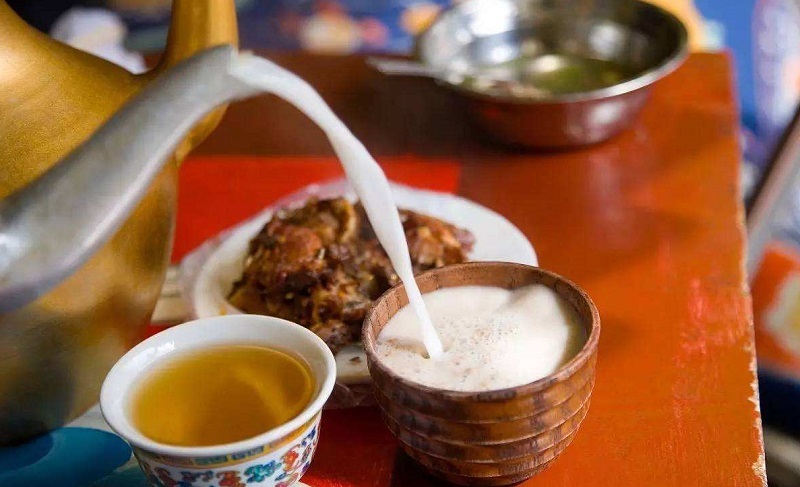
When it comes to drinks, they have various beverages as a part of their food, including butter tea, barley wine, and sweet tea. Other famous regional foods include Zabna and butter. They used a small amount of ghee and soda to soak tea together, add salt, and stir with a long stick for a few minutes. Most Tibetans regard ghee as a luxury when making tea. >> See more about Tibetan Food
Tibetan Architectural Style
Tibetans live in houses that are always constructed with stones and wood, but are very stable. The apartments are one or two-story alleys with a round window inside. Also, the yak hair tents are always built in the area they pasture. These tents are usually square with pillars supporting them. Many of these structures can withstand wind and storms. They always have a table for worshipping Buddha because of their belief. >> See more about Tibetan Architecture
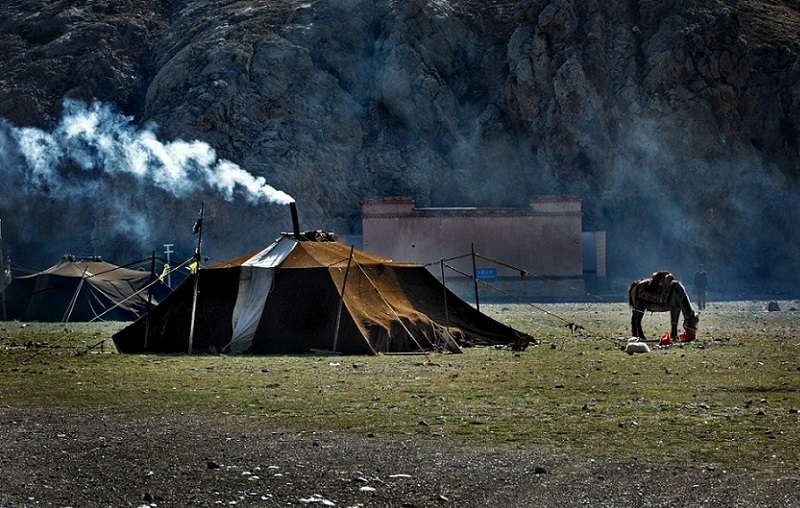
Occupational Life in Tibet
Tibet is a place of farmers, settled in small villages of Tibet. Farmers make their livestock from the main crop, barely, while roaming nomads in Tibet earn their living by herding sheep and yaks.
If we talk about city life in Tibet, most of them are making their living as craftsmen. However, Tibet inhabitants are diverting toward businesses now, but their original lifestyles will not disappear.
Religion in Tibet
We see the mix of religions in Tibet where most of the people are Buddhist followers, and few of them are believers of old Bon. In Lhasa and Yanjing, few followers of Islam Catholicism are also seen.
Jokhang Temple and Sera Monastery are famous religious places. In the streets, you will see significant elements of Tibetan Buddhism such as Mani stones, colorful prayer flags, and people maneuvering prayer wheels. >> See more about Top 10 Monasteries in Tibet
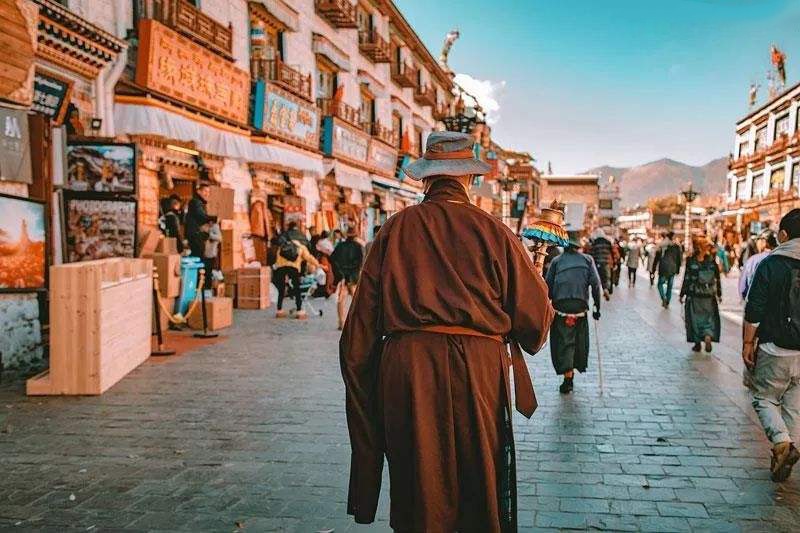
Language in Tibet
Tibetan is the primary language spoken in the region belonging to Sino-Tibetan phylum. The Tibet land was traditionally divided into three dialect boundaries; U-Tsand, Amdo, and Kham. Like other ethnic groups in China, people speaking different dialects may feel difficult to have a dialogue with each other. While the Tibetan language is spelled in the ancient Tibetan phonic symbol and does not get influenced by dialectical pronunciation, so they can write in the same way. In recent years, English is the language of the tourism business in Tibet. Many Indian merchants in Tibet speak Hindi, whereas Nepalese merchants speak Nepalese.
Entertainment in Tibet
Tibet residents love to play games and have enjoyment in their life. They enjoy distinctive traditional entertainment activities like wrestling, horse racing, tug-of-war, and archery.
Knows as the ‘Sea of Dance and Songs’, Tibet residents love music and dance. You will enjoy their fabulous dance and music if you visit the area. Moreover, various ethnic festivals are held in the region every year.
In the spring season, after plowing crops, they enjoy the Guozhuang festival, a chance for all locals to get together to sing and dance. Just before the autumn harvest, another charming Wangguo festival takes place here. The festival lasts for three to five days allowing people to wear their favorite clothing, make colorful prayer flags, sing, and dance, beat drums, and walk around the fields. Horsing racing is another charming feature of this festival.
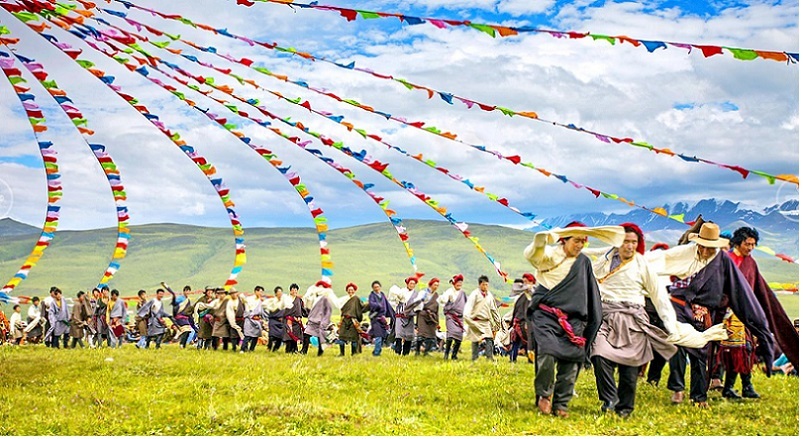
If you are planning to visit Tibet, you shouldn’t wait any longer. A lot of charm is waiting there for you. You will have a unique experience with Tibet residents who are incredibly hospitable and warm to their guests. They offer a gift basket to their guests and make their time pleasant.
Tibetan people and lifestyles always keep a mysterious veil from the public. To explore this holy land, a lot of travelers head to Tibet. Maybe you will come someday. Please feel free to contact us to help you.
Related Articles
- Tibetan Language
- Tibetan Clothing and Diverse Tibetan Dress Culture
- Tibet History
- Tibetan Food and Cuisine
- Tibetan Architecture
- Tibetan Nomads
- Tibet Religion
Email response within 0.5~24 hours.


